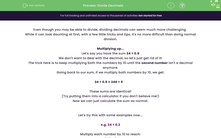Even though you may be able to divide, dividing decimals can seem much more challenging.
While it can look daunting at first, with a few little tricks and tips, it's no more difficult than doing normal division.
Multiplying up...
Let's say you have the sum 24 ÷ 0.5
We don't want to deal with the decimal, so let's just get rid of it!
The trick here is to keep multiplying both the numbers by 10 until the second number isn't a decimal anymore.
Going back to our sum, if we multiply both numbers by 10, we get:
24 ÷ 0.5 = 240 ÷ 5
These sums are identical!
(Try putting them into a calculator if you don't believe me!)
Now we can just calculate the sum as normal.
Let's try this with some examples now...
e.g. 24 ÷ 0.2
Multiply each number by 10 to reach:
240 ÷ 2
Then calculate the sum as normal:
24 ÷ 0.2 = 120
It's as simple as that!
e.g. 375 ÷ 0.05
Multiply each number by 10 to reach:
3750 ÷ 0.5
As the second number is still a decimal, we need to multiply by 10 again to get:
37500 ÷ 5
Now we can calculate as normal!
375 ÷ 0.05 = 7500
In this activity, you will practise dividing whole numbers and decimals by each other, removing the decimal places by multiplying both numbers by multiples of 10.








